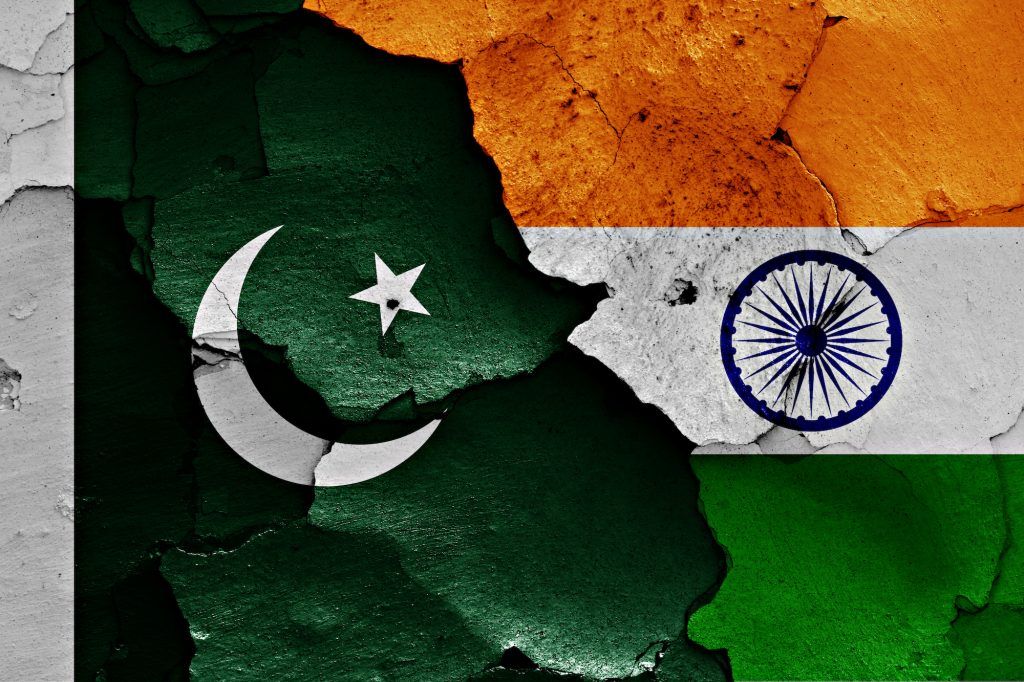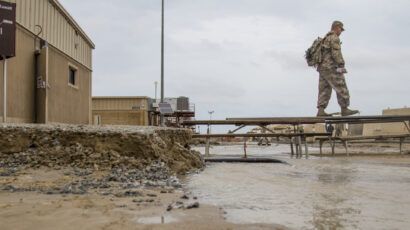Kashmir, climate change, and nuclear war
By Zia Mian | December 7, 2016

In April 2016, speaking at the conclusion of the Nuclear Security Summit in Washington DC, which had brought together more than 50 government leaders, President Obama described what he saw as the three major nuclear weapons challenges. Along with difficulties in achieving further nuclear arsenal reductions by the United States and Russia and the problem of North Korea, President Obama listed Pakistan and India and the need, as he put it, for “making sure that as they develop military doctrine that they are not continually moving in the wrong direction.” The White House press secretary later explained that underlying the President’s concern about South Asia was “the risk that a conventional conflict between India and Pakistan could escalate to include the use of nuclear weapons.” It is a well-founded fear and one that has become more urgent as tensions between Pakistan and India have escalated.
Kashmir. A potential trigger for armed conflict that might escalate to nuclear war between Pakistan and India is the dispute over the land and people of Kashmir. Pakistan has claimed this territory since the partition of British India in 1947 that created the borders of India and Pakistan. The dispute has led already to three wars, in 1947, 1965, and 1999, and left Kashmir divided between Pakistan and India along a Line of Control where the armies of Pakistan and India now confront each other in an uneasy stalemate. There are recurring artillery exchanges along this Line of Control, despite a 2003 cease-fire agreement. At times this firing has claimed significant military and civilian casualties.
As part of its efforts to pressure India into giving up Kashmir, Pakistan has backed Kashmiri insurgents and used Islamist militants to launch attacks across the Line of Control. In September 2016, a group of militants killed 18 soldiers during an attack on an Indian army base in Kashmir. Indian authorities held Pakistan responsible, and there were demands for a decisive response. The presenter of India’s leading English language news television program declared, “We need to cripple them, we need to bring them down on their knees,” while G. D. Bakshi, a retired Major General of the Indian army, argued “Pakistan is one-fifth the size of India. If we fire even a part of our arsenal, most of it will be on the Pakistani Punjab, from where the Pakistani army comes: Not a crop will grow there for 800 years!” He demanded, “Let’s stop self-deterring ourselves.”
Thankfully the situation did not escalate. Instead, India claimed to have carried out “surgical strikes” across the Line of Control against the “launching pads of militants,” as part of which Indian forces entered more than a kilometer into Pakistan-held Kashmir. Pakistan denies these strikes took place. The continuing futility of the situation was highlighted in late November when armed militants launched another attack on an Indian army camp in Kashmir, this time killing seven soldiers and taking hostages before being killed.
Frustration in the armies on both sides has led to furious, seemingly indiscriminate firing across the Line of Control. The scale of civilian casualties has led hundreds of people to flee their homes on both sides of the line; local villagers say it seems as “if a full-blown war is going on between India and Pakistan.”
Meanwhile many Kashmiris have turned to supporting groups resisting Indian rule and been met with repression from security forces. Since July, an estimated 17,000 people (including children) have been injured, more than 90 killed, and thousands arrested. Reflecting on India’s pattern of using force against the Kashmiris it claims as its citizens, Kashmiri journalist and writer Basharat Peer has observed grimly that in this forever war “the news of death is frequent in Kashmir, and so are occasions of protest. Another generation of young Kashmiris is being consumed by war.”
It is not just attacks by Pakistan-backed militants on Indian forces in Kashmir and subsequent Indian reprisals that could escalate and tip the two countries into another major war. A related trigger would be an attack on an Indian city by Islamist militant groups, along the lines of the assault on Mumbai in November 2008 that claimed hundreds of casualties and was linked to intelligence agencies in Pakistan. Demands in India for a forceful response to another such attack would be hard for political leaders to resist. As George Perkovich and Toby Dalton argue in their important new book, Not War, Not Peace? Motivating Pakistan to Prevent Cross-Border Terrorism, the use of military force by India at levels that could compel Pakistan to abandon its use of militant proxies also would carry serious risks of Pakistani retaliation and escalation to the threat and use of nuclear weapons.
The threat of nuclear war hangs in the background over Kashmir. In 2013, India’s Civil Defense and State Disaster Response Force placed a paid advertisement in a Kashmiri newspaper informing local citizens about preparing for nuclear war. Echoing Cold War nuclear civil defense messaging, the instructions explained the importance of building nuclear shelters and stockpiling two weeks of food and water and let people know that if they were outside at the time of a nuclear attack they should “immediately drop to ground and remain in lying position” and “expect some initial disorientation” from the destruction that could be caused.
Some even seem to welcome the prospect of nuclear war. Syed Salahudeen, the head of the Kashmir-based militant group Hizbul Mujahideen, which has been armed and supported by Pakistan, warned in 2016 of a fourth war over Kashmir and declared, “If Pakistan provides support, there is a great chance of a nuclear war between two powers (India and Pakistan).”
The climate-water conflict. Along with the risks of war triggered by an escalation along the Line of Control in Kashmir or by attacks on Indian cities by Islamist militants backed by Pakistan, a new source of conflict between Pakistan and India has emerged, also centered on Kashmir. It is a struggle over access to and control over the water in the rivers that start as snow and glacial meltwater in the Himalayas and pass through Kashmir on their way to Pakistan as the Indus River Basin, ending in the Arabian Sea.
The Indus River and its tributaries are central to Pakistan’s water supply, food supply, and electricity production, and India relies on some of the same water. Under the 1960 Indus Waters Treaty, Pakistan has control over the Indus, Jhelum, and Chenab Rivers, and India manages the Sutlej, Beas, and Ravi rivers until they cross into Pakistan and all merge into the Indus River. The treaty was established in part because of conflicts over water between the two countries following independence in 1947, including an Indian decision in 1948 to block some of the water flowing into Pakistan during the first India-Pakistan war over Kashmir.
As water demand in both countries has grown to meet the needs of rapidly growing populations and increased agriculture and industrial use, large hydroelectric dams have been constructed, and renewed disputes are testing the Indus Waters Treaty. A 2011 United States Senate Foreign Relations Committee report assessed that “water may prove to be a source of instability in South Asia [as] new demands for the use of the river flows from irrigation and hydroelectric power are fueling tensions between India and Pakistan. A breakdown in the [Indus Water] treaty’s utility in resolving water conflicts could have serious ramifications for regional stability.” The report concluded grimly that “the United States cannot expect this region to continue to avoid ‘water wars’ in perpetuity.”
This is not a new concern. As long ago as 2002, Indian Water Resources Minister Bijoya Chakroborty threatened, “If we decide to scrap the Indus Water Treaty, then there will be drought in Pakistan, and the people of that country would have to beg for every drop of water.”
After the September 2016 attack by militants on an Indian army base in Kashmir, India announced plans to accelerate construction of dams in Kashmir on the rivers that flow into Pakistan and to suspend the bilateral Indus Waters Commission that administers the treaty and manages disputes over its implementation. India’s Prime Minister Narendra Modi declared “blood and water cannot flow together.” Pakistan for its part has announced that an Indian revocation of the treaty could be taken as an “act of war.”
Pakistan’s government, nationalist and militant organizations, and right-wing media frequently now present India’s construction of dams in Kashmir as a pressing national security threat and one that may call for extreme responses. An editorial in one leading urdu-language Pakistani newspaper in 2011 declared “Pakistan should convey to India that a war is possible on the issue of water and this time war will be a nuclear one.”
Nuclear forces and postures. Since the Indian and Pakistani nuclear weapon tests of May 1998, the two states have expanded many-fold their respective nuclear weapon and fissile material stockpiles and undertaken extensive development and testing of a diverse array of ballistic and cruise missiles (with ranges from 60 to 5000 kilometers), acquiring the ability to deploy and launch nuclear weapons from the air, from land, and from submarines at sea. They have put in place command and control systems and doctrines that involve, in the case of Pakistan, first use of nuclear weapons in a conflict and, in the case of India, massive retaliatory strikes against population centers.
In 1999, the two countries fought a war which apparently included mobilization of nuclear weapons by Pakistan, making it the most significant military conflict between two nuclear armed states. They also went through a major military crisis (December 2001 to June 2002) triggered by an attack on India’s parliament by Islamist militants believed in India to be backed by Pakistan. The response to the attack included the two countries moving a combined total of more than half a million troops to their border.
The slow pace of Indian deployment and inconclusive outcome of the stand-off led India’s army to begin planning and training for a more decisive and rapid conventional attack on Pakistan. Pakistan began testing a short-range, truck-mounted missile to deliver low-yield nuclear weapons on the battlefield. This latter development has increased longstanding international concerns about the security of nuclear weapons and fissile materials in Pakistan, given the large-scale and frequent Islamist militant attacks on military targets in the country and the ideological polarization within the armed forces and broader society associated with the rise of hardline Islamist political groups over the past three decades.
Pakistan has long been explicit about its plans to use nuclear weapons to counter Indian conventional forces. In March 2015, the former head of Pakistan’s Strategic Plans Division, retired General Khalid Kidwai, announced that the country had developed “a variety of short range, low yield nuclear weapons.” Pakistani Foreign Secretary Aizaz Ahmad Chaudhry declared that his country might use these tactical nuclear weapons in a conflict with India. The New York Times reported in 2015 that so far, “an unknown number of the tactical weapons were built, but not deployed” by Pakistan.
From tactical weapons to massive retaliation. India anticipates that Pakistan might use nuclear weapons against Indian conventional forces during a war. The Indian Army conducted a massive military exercise in April 2016 in the Rajasthan Desert bordering Pakistan, involving tanks, artillery, armored personnel carriers, and 30,000 soldiers who practiced what they would do if attacked with nuclear weapons on the battlefield. An Indian Army spokesman told the media that “our policy has been always that we will never use nuclear weapons first. But if we are attacked, we need to gather ourselves and fight through it. The simulation is about doing exactly that.” This was not the first such exercise.
Indian nuclear doctrine also calls for massive retaliation directed at Pakistani cities, and Pakistan has threatened to respond in kind. In 2003, India’s cabinet declared nuclear weapons “will only be used in retaliation against a nuclear attack on Indian territory or on Indian forces anywhere… [N]uclear retaliation to a first strike will be massive and designed to inflict unacceptable damage.” According to Admiral Vijay Shankar, a former head of Indian strategic nuclear forces, such retaliation would involve nuclear attacks on Pakistan’s cities.
General Kidwai from Pakistan describes such Indian threats as “bluster and blunder,” since they “are not taking into account the balance of nuclear weapons of Pakistan, which hopefully not, but has the potential to go back and give the same kind of dose to the other side.” This seems an explicit suggestion of Pakistan planning to target Indian cities with nuclear weapons in retaliation of Indian nuclear attacks on Pakistani cities.
From regional war to great power war. Time is not on our side. The failure to settle the Kashmir dispute despite the passage of 70 years has already triggered three wars. While Pakistan clings grimly to its claims on Kashmir, India seems less inclined to compromise as it grows in economic and military power. Adding to this will be the inevitable pressures from climate change over the coming decades on the Himalayan glaciers, the monsoons, and ground water in the Indus Basin, which will lead to reduced and less reliable access to water in an already water-stressed region, at a time of rapidly growing demand. These drivers have already started to overlap, and conflicts over land, people, blood, and water may become one.
Once initiated, possibly even by the actions of a small militant group, a Pakistan-India conflict may well escalate into a larger war and then bring in allied outside powers, as happened in Europe in World War I.
Pakistan is building ever closer military and economic ties to China; India is becoming a strategic partner of the United States. These alliances with great powers may give policy makers in Pakistan and Indian confidence in escalating a conflict and issuing nuclear threats during a crisis. Because of the increasingly tense and militarized nature of the rivalry between China and the United States, a South Asian conflict that draws them in could escalate into a potentially far more destructive war.
Given these risks, forestalling crises and possible war in South Asia should be a priority. The long history of failures to find a path to peace for Kashmir through United Nations resolutions and bilateral Pakistan-India agreements seems to have sapped the will to try to address the dispute directly. Preventing a South Asian war from becoming nuclear war will require progress on banning the bomb.
Together, we make the world safer.
The Bulletin elevates expert voices above the noise. But as an independent nonprofit organization, our operations depend on the support of readers like you. Help us continue to deliver quality journalism that holds leaders accountable. Your support of our work at any level is important. In return, we promise our coverage will be understandable, influential, vigilant, solution-oriented, and fair-minded. Together we can make a difference.
Topics: Analysis, Nuclear Weapons















